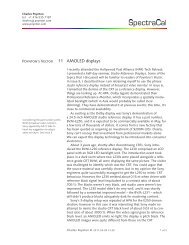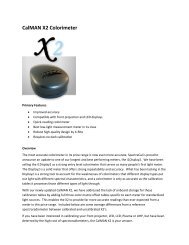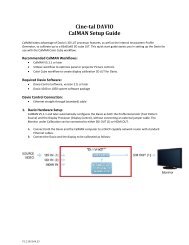7 Primaries for HD - SpectraCal
7 Primaries for HD - SpectraCal
7 Primaries for HD - SpectraCal
You also want an ePaper? Increase the reach of your titles
YUMPU automatically turns print PDFs into web optimized ePapers that Google loves.
Charles Poynton<br />
tel +1 416 535 7187<br />
charles @ poynton.com<br />
www.poynton.com<br />
Poynton’s Vector 7 <strong>Primaries</strong> <strong>for</strong> <strong>HD</strong> content<br />
In last month’s article I discussed the demise of the CRT as the definitive<br />
display device <strong>for</strong> approving colour content of <strong>HD</strong> programming.<br />
The inability of content creators to obtain CRT reference displays<br />
causes an immediate need <strong>for</strong> a replacement. However, even in the era<br />
when CRT reference displays were viable, there was a latent issue that<br />
no one talked about, and it’s that issue that I’d like to raise this<br />
month: Worldwide standards <strong>for</strong> <strong>HD</strong> specify BT.709 primaries.<br />
If you’re a consumer video expert, perhaps a home theatre calibrator,<br />
you say, well, of course, that’s obvious! But let’s investigate.<br />
ITU-R Rec. BT.709 is the main international standard <strong>for</strong> <strong>HD</strong> content.<br />
R’G’B’ values are supposed to be displayed according to a particular<br />
set of primary chromaticities specified in the document. The Recommendation<br />
was adopted in 1990. (It was called ccir Rec. 709 at the<br />
time). In the years following, various national and continental standards<br />
followed suit. For example, smpte 274M, the main studio<br />
production standard in North America, states:<br />
“Equipment should be designed in accordance with the colorimetric<br />
analysis … defined in this section. This corresponds to ITU-R BT.709.”<br />
Comparable provisions are found in atsc, dvb, and ebu standards.<br />
In 1993, the computer industry enthusiastically adopted the BT.709<br />
primaries as one aspect of the sRGB standard. The sRGB standard is<br />
now ubiquitous <strong>for</strong> desktop computing, not just <strong>for</strong> stills (such as Exif<br />
JPEGs), but <strong>for</strong> video: sRGB video encoding is implicit in new video<br />
distribution channels such as YouTube, Skype, the Apple iTunes Store,<br />
Hulu.com, Netflix, and so on.<br />
Sony’s BVM-D32E1W CRT was the<br />
“gold standard” studio reference<br />
display. It was available with smpte<br />
or ebu phosphors – but was never<br />
offered with BT.709 phosphors!<br />
However, <strong>HD</strong> content creators hold a dark secret: Following<br />
international agreement on BT.709 in 1990, content creators in 60 Hz<br />
countries never switched from the smpte primaries of 480i SD to the<br />
BT.709 primaries, and content creators in 50 Hz countries never<br />
switched from the ebu primaries of 576i SD to the BT.709 primaries.<br />
<strong>HD</strong> content is generally not approved on BT.709 displays! smpte “C”<br />
(RP 145) primaries remain entrenched <strong>for</strong> 60 Hz <strong>HD</strong> in North America,<br />
Japan, and much of Asia; ebu primaries remain entrenched <strong>for</strong> 50 Hz<br />
<strong>HD</strong> in Europe and other parts of the world.<br />
Charles Poynton © 2010-08-06 1 of 2
2 PRIMARIES FOR <strong>HD</strong> CONTENT<br />
BT.709 supposedly exists <strong>for</strong> international exchange; however, international<br />
<strong>HD</strong> program exchange in practice does not use BT.709. We find<br />
ourselves in the ironic situation that studio and broadcast <strong>HD</strong>TV does<br />
not use the “<strong>HD</strong>TV” (BT.709) primaries, but the computer industry has<br />
embraced them to the virtual exclusion of everything else! (Displays<br />
having Adobe RGB 1998 primaries are deployed in limited numbers<br />
<strong>for</strong> applications in high-end graphics arts.)<br />
SD and <strong>HD</strong> luma coefficients differ,<br />
necessitating a trans<strong>for</strong>m of Y’C B C R<br />
upon conversion between SD and<br />
<strong>HD</strong>. Within any geographical region<br />
the underlying R’G’B’ are identical,<br />
though, so the discrepancy in luma<br />
coefficients has absolutely no effect<br />
on colour gamut or “colour space.”<br />
By the way, there’s no such thing as<br />
“BT.601 colour space.” BT.601 is<br />
primary-agnostic. It is implicit that<br />
480i content has smpte primaries<br />
and 576i content has ebu primaries.<br />
High-end <strong>HD</strong> production and distribution standards conversion equipment<br />
(such as from Snell & Wilcox and Teranex) can be configured to<br />
per<strong>for</strong>m colour primary trans<strong>for</strong>ms among smpte, ebu, and BT.709<br />
primaries at the time that programme material is subject to standards<br />
conversion (say from 60 Hz to 50 Hz). However, if such a conversion is<br />
done, gamut clipping and gamut mapping issues are liable to arise. In<br />
my view, it is best to leave the R’G’B’ alone, and live with some small<br />
systematic colour errors (which are unlikely to be visible without<br />
comparison to the original) rather than risk gamut clipping (which is<br />
likely to be visible even without access to the original).<br />
At the consumers’ premises, 60 Hz content has almost certainly been<br />
mastered with smpte primaries. If you’re a home theatre calibrator,<br />
you may be tempted to calibrate your display primaries to the smpte<br />
spec rather than BT.709. In my view that would be a mistake, <strong>for</strong> the<br />
reason that I mentioned a moment ago in connection with colour<br />
primary trans<strong>for</strong>ms in production: The risk of artifacts from colour clipping<br />
outweighs any advantage in colour accuracy – and in any event,<br />
when transmitted through an atsc or dvb channel, the content effectively<br />
declares itself to be BT.709, so that’s how you should display it.<br />
Studio display manufactures will face increasing difficulty in sustaining<br />
a pair of legacy chromaticity sets (smpte and ebu) <strong>for</strong> high end <strong>HD</strong><br />
content, especially when the discrepancy with BT.709 confers no functional<br />
benefit. In the face of increasingly global distribution of television<br />
programmes, and with a single worldwide standard <strong>for</strong> desktop<br />
computing used in emergent video distribution technologies, it will be<br />
increasingly difficult <strong>for</strong> content creators, aggregators, and broadcasters<br />
to justify different primary chromaticities <strong>for</strong> 50 Hz and 60 Hz<br />
regions. The next 1 to 4 years will see replacement of CRTs across<br />
virtually the entire installed base of studio reference displays. Deployment<br />
of FPD studio reference displays (not “monitors”; see Issue 5)<br />
provides an opportunity <strong>for</strong> broadcasters throughout the world to<br />
migrate to BT.709 primaries. In my view, that’s the only sensible way<br />
<strong>for</strong>ward is BT.709. If you’re a home theatre enthusiast, calibrating to<br />
BT.709 prepares you <strong>for</strong> this eventuality.<br />
Wide-gamut television receivers are now commercially available that<br />
warp perfectly reasonable BT.709 colours into regions of colourspace<br />
that the content creators never intended: I call it wild gamut. Faithful<br />
presentation cannot be achieved with such processing. <strong>HD</strong>MI 1.4 and<br />
xvYCC/x.v.Color are implicated. The development of legitimate wide<br />
gamut will be the subject of a future issue. Meanwhile, I welcome<br />
your comments!
















